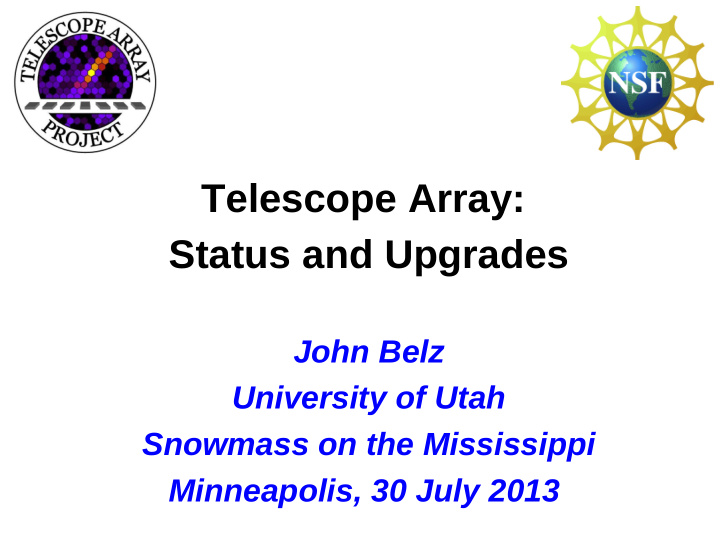



Telescope Array: Status and Upgrades John Belz University of Utah Snowmass on the Mississippi Minneapolis, 30 July 2013
Outline • Telescope Array Overview – Detector – Physics • TA Upgrades – TALE – TA x 4 – NICHE • TA Affiliate Experiments – ELS – TARA – Lightning Detection
SD/FD Energy Scale First estimate of SD Energy: MC lookup table
Composition: Stereo X max
TA Upgrades • Low-energy extension; TALE
TA Low Energy Extension (TALE) • Study 10 16 and 10 17 eV decades in hybrid • Astrophysics – End of “knee” – Second knee – Galactic-Extragalactic Transition • High-energy physics: Cross- section measurements overlapping LHC
TALE Detectors are being deployed. TALE mirrors TALE FD at MD TA mirrors TALE hybrid events per year TALE infill array TA SD LHC energy
TALE: P-Air Total Cross Section at LHC Energies Figure: PAO The falling tail is a convolution of the first-interaction exponential and the variation of depth of X max .
Unresolved by TA: Anisotropy • Map of a priori significance for TA events > 57 EeV
TA Upgrades • TA x 4 • 3,000 km 2 – 500 SD's, 2 km spacing – 1 new FD (HiRes refurbished) • Proposals fall 2013 • Anisotropy: 20 TA- SD years by 2019
Telescope Array Affiliate Experiments
TARA: Radar Detection of Cosmic Ray Showers • Low rates at high energies → need aperture! • Bistatic radar – Remote sensing – Inexpensive – 100% duty cycle 54.1 MHz, 8 MW ERP phased array Simulated “chirp” detected at -10 dB SNR
TA/LMA: Lightning Mapping • Cosmic rays may trigger lightning strikes. • Lightning does emit air shower-like bursts of particles. • Proposing to deploy lightning mapping array (LMA) at TA to study these phenomena.
Summary • Telescope Array is the largest cosmic ray observatory in the Northern Hemisphere. • Has measured spectrum, composition and anisotropy above 10 18 eV. • Planned upgrades will: – Increase aperture x4 (anisotropy) – Increase range to nearly 5 orders of magnitude(!) – Measure cross-sections at LHC energies • Rich program of affiliate experiments
Recommend
More recommend